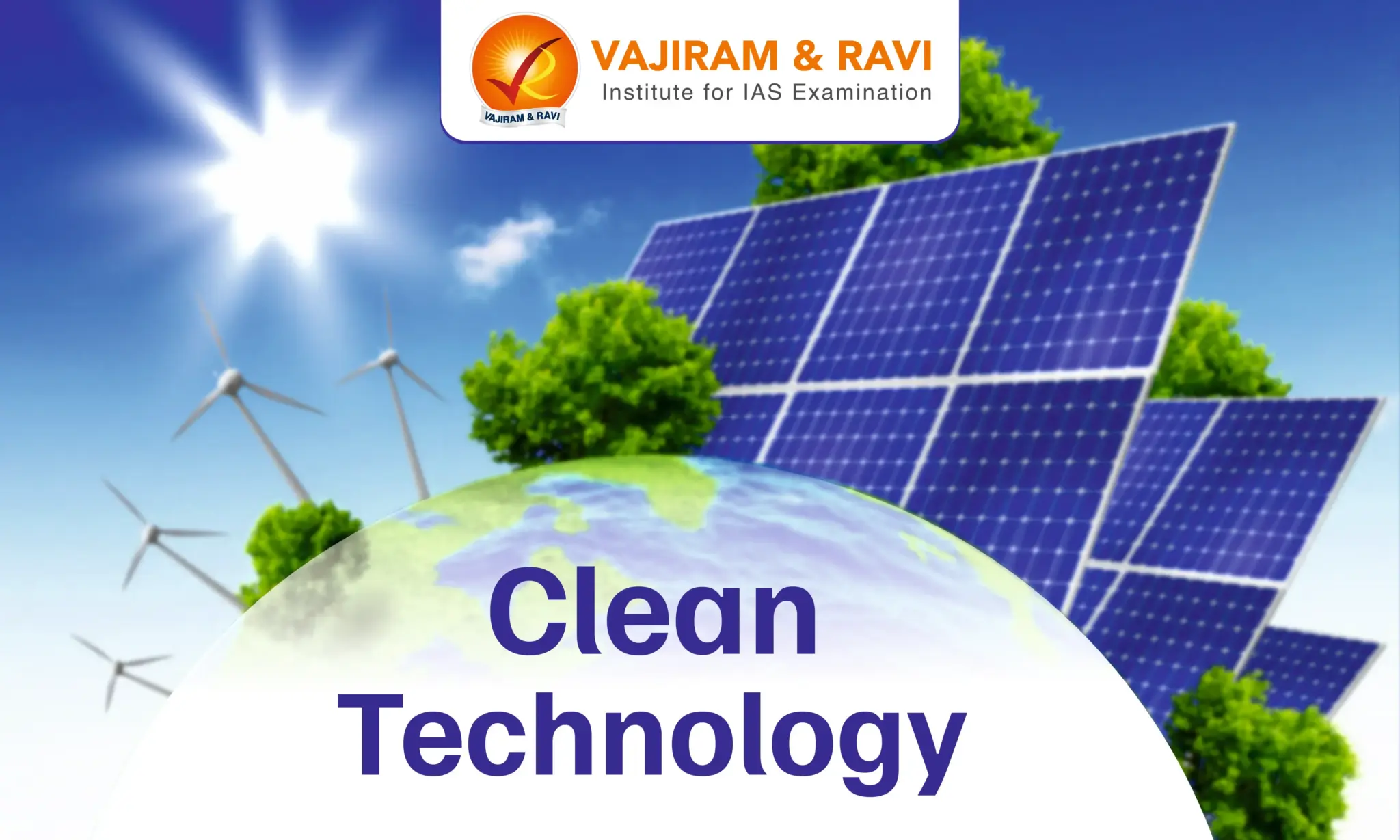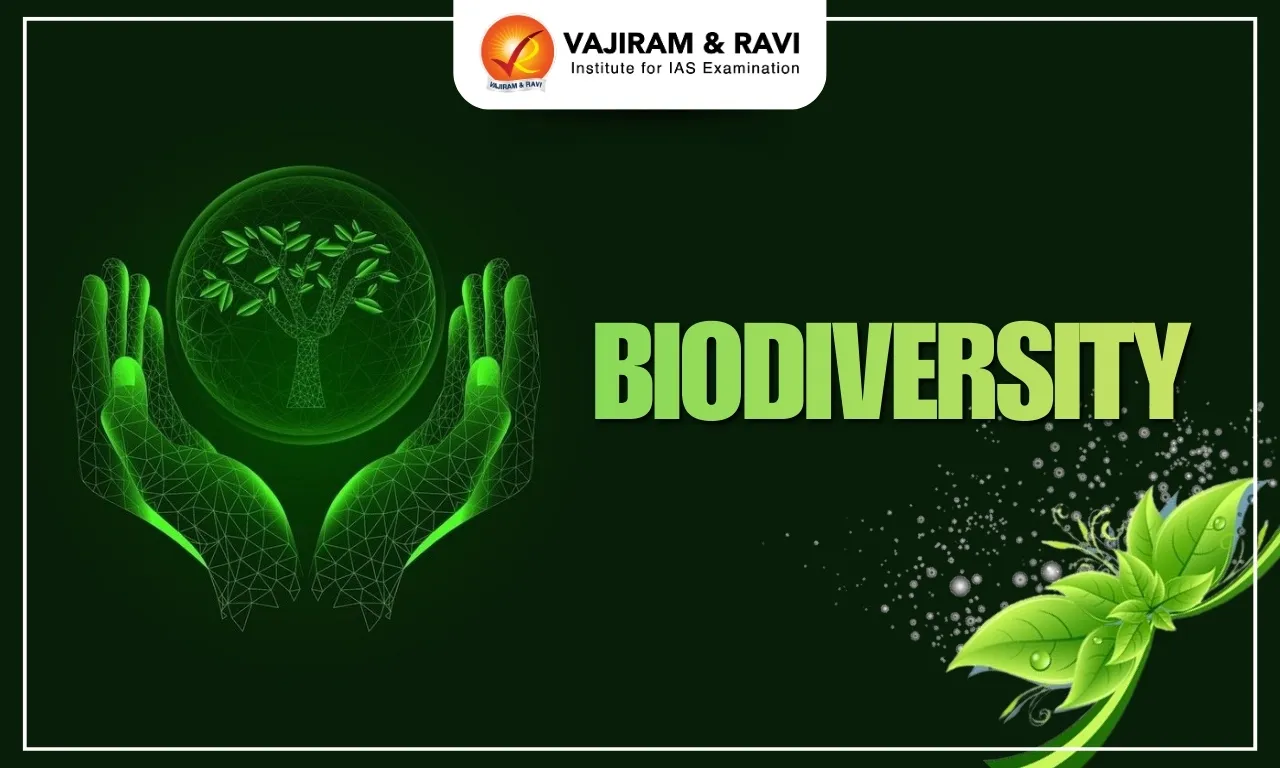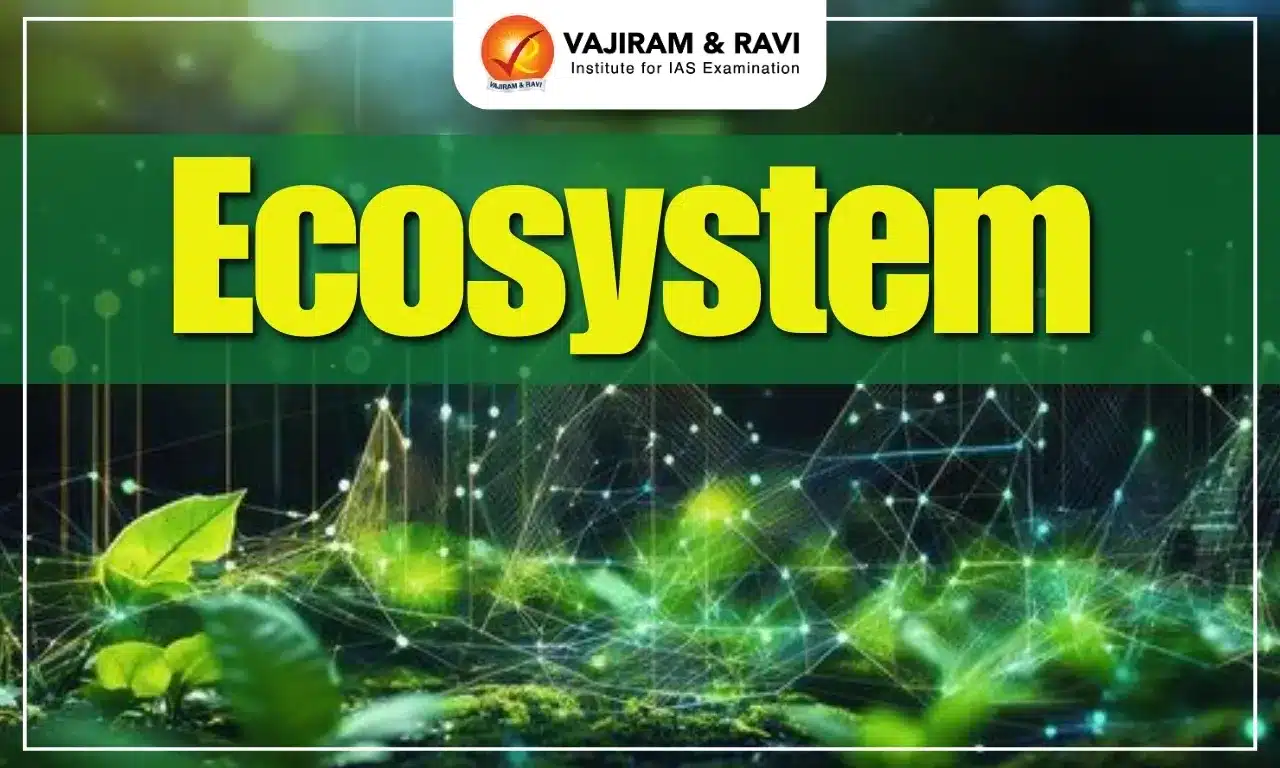Clean technology also known as green technology, refers to products, services and processes that utilise renewable materials and energy sources. The significance of clean technology lies in its potential to decarbonise the energy system. By deploying solutions for the storage and applications of renewable energy, clean technology can help mitigate climate risks and advance sustainable development.
Clean technology is crucial for India for energy security and maintaining high economic growth rates while ensuring ecological sustainability. It promises new industries and jobs creating green GDP, and energising programs like Make in India through renewed manufacturing.
Clean Technological Solutions
Clean technologies are essential for sustainable development and reducing the impacts of climate change. Some key clean technologies include:
| Clean Technology | Details | Applications |
| Fuel cells |
- These are electrochemical devices that convert the chemical energy of a fuel (hydrogen, methanol etc.) directly into electricity without any combustion. - The fuel is oxidised at the anode, while oxygen is reduced at the cathode. The reaction produces electricity, water, and heat. |
Vehicles, buildings, electronic devices, etc. |
| Solar Photovoltaic cells |
- They convert sunlight directly into electricity via the photovoltaic effect using semiconducting materials like silicon, cadmium telluride or thin films. - When sunlight strikes the cell, the photons are absorbed, exciting electrons which then flow through the material producing current. |
Solar-powered irrigation, solar rooftop net metering models, solar parks/highways, etc. |
| Lithium-ion Batteries |
- These are rechargeable batteries, widely used in energy storage systems due to their high energy density, long cycle life, relatively low self-discharge, and no memory effect. - They use lithium ions that move between a graphite anode and a lithium metal oxide cathode through an electrolyte. This flow of ions generates current. |
Electric Vehicles, grid integration of renewable energy, etc. |
| Solid-state Batteries | - They use solid electrodes and a solid electrolyte for higher energy density and safety than the Li-ion batteries. | Electric vehicles and grid storage applications (once commercialised). |
| Hydrogen Fuel and Green Hydrogen | - Produced by splitting water into hydrogen and oxygen using renewable electricity. | Decarbonise hard-to-abate sectors, store renewable energy and balance the grid. |
| Electric Vehicles | - Use electric motors powered by large onboard batteries, producing no direct emissions. | Decarbonising the transport sector. |
| Nuclear Fusion |
- Fuses light atomic nuclei at high temperatures, releasing massive amounts of energy. - In the long run, safe fusion power from reactors like the Tokamak can be a game-changer in meeting massive clean energy needs |
Abundant, reliable clean energy (still experimental). |
| Biofuels |
- These are renewable fuels, made from biological sources like plants and animal waste.
- Advanced biofuels are made from non-edible parts of plants or microorganisms using genetic engineering. |
Energy production, transportation, reducing greenhouse gas emissions and enhancing energy security. |
| Microbial Fuel Cells | - In this, organic matter, generally waste materials, and microbes (bacteria mainly) are used as substrates and electrons are generated through the biochemical reactions. | Underwater and other remote areas monitoring devices, BOD sensing, Green hydrogen production, etc. |
India and Clean Technology
India has implemented numerous policies and programs promoting clean technology adoption to accomplish climate goals.
- Net zero by 2070 goal: India committed to achieving net zero emissions by 2070 at COP26, and pivoted on renewables expansion, EV transition, energy storage, carbon capture and green hydrogen.
- India's ambitious targets include achieving 450 GW of installed renewable capacity by 2030, reducing the total projected carbon emission intensity by 45% below 2005 levels, and increasing the share of non-fossil fuel-based electricity generation to at least 50% by 2030.
- Green Hydrogen Mission: Launched in October 2021, the mission aims to establish a robust ecosystem for green hydrogen production and utilisation, targeting 5 million tons of green hydrogen production capacity by 2030.
- Ethanol Blending Program: To promote biofuels, India mandates ethanol blending in petrol up to 20%, which helps reduce crude oil imports and lower greenhouse gas emissions.
- Lithium reserves: With lithium being a critical component in battery manufacturing,
- India has identified potential lithium deposits in states like Andhra Pradesh, Karnataka, Rajasthan, Tamil Nadu, and Jammu & Kashmir.
- Solar energy initiatives: Several schemes, including the National Solar Mission, Rooftop Solar Programme, and Solar Park Development Scheme, support the expansion of solar energy infrastructure in India.
- India's clean energy initiatives:
- Carbon Credit trading platform: India has approved a carbon trading market to align with its COP26 pledge on capping emissions in key sectors through carbon pricing mechanisms.
- Government Investments in Clean Technology:
- Overall $4.3 Billion Green Technology Fund: India announced a fund of over $4.3 billion in the 2023-24 budget towards solar power capacity addition and green hydrogen ecosystem.
- U.S. Agency for International Development (USAID’s) Assistance to India:
- Clean energy deployment programs: USAID India initiatives like Partnership to Advance Clean Energy-Deployment (PACE-D) accelerate renewable energy deployment and efficiency improvements across states through technical capacity building.
- Women’s Entrepreneurship for Clean Tech: USAID’s wPOWER program trains women entrepreneurs on business skills for driving clean energy products adoption and empowerment.
Challenges for Clean Technology Adoption
India's transition towards clean energy adoption faces several challenges as it strives to reshape its energy landscape and meet ambitious renewable energy targets. Here are some key challenges:
- Financing: The cost burden associated with transitioning from legacy fossil fuel infrastructure to clean energy sources poses a significant financial challenge that needs to be addressed.
- The high capital costs of renewable energy projects, battery storage solutions and green hydrogen production remain key adoption barriers needing fiscal incentives.
- Regulatory issues: Challenges like range anxiety in electric vehicles (EVs) and regulatory hurdles affect the higher adoption of EVs in India.
- Import dependence: India's potential overreliance on the Chinese battery supply chain for EVs poses a risk to the country's energy security and independence.
- Inefficient energy infrastructure: High transmission and distribution losses in the energy sector prevent decisive investments in renewable energy, keeping discoms tied to existing coal-fired power plants.
- Policy implementation: Ensuring effective policy implementation, incentives, and regulatory frameworks are crucial for accelerating the adoption of renewable energy technologies in India.
- Energy access barriers: Approximately 45% of India's base of the pyramid households lack access to electricity, highlighting the need to overcome barriers to rural energy access through market-based mechanisms and partnerships.
Clean Technology UPSC PYQs
Question 1: With reference to ‘fuel cells’ in which hydrogen-rich fuel and oxygen are used to generate electricity, consider the following statements : (UPSC Prelims 2015)
- If pure hydrogen is used as a fuel, the fuel cell emits heat and water as by-products.
- Fuel cells can be used for powering buildings and not for small devices like laptop computers.
- Fuel cells produce electricity in the form of Alternating Current (AC).
Which of the statements given above is/are correct?
- 1 only
- 2 and 3 only
- 1 and 3 only
- 1, 2 and 3
Answer: (a)
Question 2: With reference to technologies for solar power production, consider the following statements: (UPSC Prelims 2014)
- 'Photovoltaics' is a technology that generates electricity by direct conversion of light into electricity, while 'Solar Thermal' is a technology that utilizes the Sun's rays to generate heat which is further used in the electricity generation process.
- Photovoltaics generates Alternating Current (AC), while Solar Thermal generates Direct Current (DC).
- India has a manufacturing base for Solar Thermal technology, but not for Photovoltaics.
Which of the statements given above is/are correct?
- 1 only
- 2 and 3 only
- 1, 2 and 3
- None
Answer: (a)
Question 3. According to India’s National Policy on Biofuels, which of the following can be used as raw materials for the production of biofuels? (UPSC-2020)
- Cassava
- Damaged wheat grains
- Groundnut seeds
- Horse gram
- Rotten potatoes
- Sugar beet
Select the correct answer using the code given below:
(a) 1, 2, 5 and 6 only
(b) 1, 3, 4 and 6 only
(c) 2, 3, 4 and 5 only
(d) 1, 2, 3, 4, 5 and 6
Answer (a)
Last updated on November, 2025
→ Check out the latest UPSC Syllabus 2026 here.
→ Join Vajiram & Ravi’s Interview Guidance Programme for expert help to crack your final UPSC stage.
→ UPSC Mains Result 2025 is now out.
→ UPSC Notification 2026 is scheduled to be released on January 14, 2026.
→ UPSC Calendar 2026 is released on 15th May, 2025.
→ The UPSC Vacancy 2025 were released 1129, out of which 979 were for UPSC CSE and remaining 150 are for UPSC IFoS.
→ UPSC Prelims 2026 will be conducted on 24th May, 2026 & UPSC Mains 2026 will be conducted on 21st August 2026.
→ The UPSC Selection Process is of 3 stages-Prelims, Mains and Interview.
→ UPSC Result 2024 is released with latest UPSC Marksheet 2024. Check Now!
→ UPSC Prelims Result 2025 is out now for the CSE held on 25 May 2025.
→ UPSC Toppers List 2024 is released now. Shakti Dubey is UPSC AIR 1 2024 Topper.
→ UPSC Prelims Question Paper 2025 and Unofficial Prelims Answer Key 2025 are available now.
→ UPSC Mains Question Paper 2025 is out for Essay, GS 1, 2, 3 & GS 4.
→ UPSC Mains Indian Language Question Paper 2025 is now out.
→ UPSC Mains Optional Question Paper 2025 is now out.
→ Also check Best IAS Coaching in Delhi
Clean Technology FAQs
Q1. What are clean technologies?+
Q2. How do clean technologies help the environment?+
Q3. What are some benefits of adopting clean technologies?+
Q4. What is the National Hydrogen Mission?+
Q5. What is the National Bioenergy Mission?+
Tags: clean technology quest

















